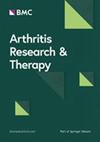Discontinuation vs. continuation of concomitant methotrexate in patients with rheumatoid arthritis on certolizumab pegol: results from a randomised, controlled trial
IF 4.6
2区 医学
Q1 Medicine
引用次数: 0
Abstract
The present non-inferiority study was designed to compare the effect of discontinuing versus continuing methotrexate (MTX) alongside certolizumab pegol (CZP) on maintaining low disease activity (LDA) in rheumatoid arthritis (RA) patients already stable on combination therapy. This multicentre, open-label, randomised, controlled trial included RA patients with sustained LDA (Clinical Disease Activity Index [CDAI] ≤ 10) for ≥ 12 weeks with CZP + MTX. Patients were randomised 1:1 by computer to either continue MTX (CZP + MTX group) or discontinue MTX after a 12-week reduction period (CZP group) using a dynamic allocation strategy with the minimisation method. The primary endpoint was the proportion of patients maintaining LDA without a flare (i.e., a CDAI score > 10 or intervention with rescue treatments for any reason) at week 36 (24 weeks after MTX discontinuation). Non-inferiority is verified if the lower limit of the 90% confidence interval (CI) using normal approximation for the difference in the proportion of cases that maintained LDA at week 36 between the intervention group and control group exceeds the non-inferiority margin. All 84 screened patients were randomised to the CZP + MTX group (n = 41) and CZP group (n = 43), and were included in the efficacy analysis. Proportions (90% CI) of patients who maintained LDA at week 36 were 85.4% (76.3 to 94.4%) in the CZP + MTX group and 83.7% (74.5 to 93.0%) in the CZP group. The difference (90% CI) between the two groups was − 1.6% (-14.6 to 11.3%), with the lower limit of the 90% CI exceeding the non-inferiority margin of -18%. Reported adverse events were broadly similar between the two groups. The proportion of patients with gastrointestinal symptoms, as assessed by a self-administered questionnaire, was significantly lower in the CZP group than in the CZP + MTX group at week 36 (2.4% vs. 15.8%, P = 0.034). Discontinuing concomitant MTX in RA patients on CZP is clinically feasible for maintaining LDA. Japan Registry of Clinical Trials (jRCTs041200048).类风湿性关节炎患者服用certolizumab pegol时停用甲氨蝶呤vs.继续使用甲氨蝶呤:来自一项随机对照试验的结果
目前的非劣效性研究旨在比较停药与继续使用甲氨蝶呤(MTX)联合certolizumab pegol (CZP)对维持已稳定联合治疗的类风湿性关节炎(RA)患者低疾病活动性(LDA)的影响。这项多中心、开放标签、随机对照试验纳入了持续LDA(临床疾病活动指数[CDAI]≤10)≥12周且使用CZP + MTX的RA患者。使用最小化方法的动态分配策略,患者通过计算机按1:1随机分组,要么继续MTX (CZP + MTX组),要么在12周减量期后停止MTX (CZP组)。主要终点是在第36周(MTX停药后24周)维持LDA且无耀斑的患者比例(即CDAI评分为bb10或任何原因的救援治疗干预)。如果干预组和对照组之间在第36周维持LDA的病例比例的差异使用正态近似的90%置信区间(CI)的下限超过非劣效性界限,则验证非劣效性。筛选出的84例患者随机分为CZP + MTX组(n = 41)和CZP组(n = 43),纳入疗效分析。在第36周维持LDA的患者比例(90% CI), CZP + MTX组为85.4% (76.3 ~ 94.4%),CZP组为83.7%(74.5 ~ 93.0%)。两组之间的差异(90% CI)为- 1.6%(-14.6至11.3%),90% CI的下限超过了-18%的非劣效性边际。两组报告的不良事件大致相似。根据自我管理问卷评估,在第36周时,CZP组出现胃肠道症状的患者比例显著低于CZP + MTX组(2.4% vs. 15.8%, P = 0.034)。在使用CZP的RA患者中,停止MTX合用对于维持LDA在临床上是可行的。日本临床试验注册中心(jRCTs041200048)。
本文章由计算机程序翻译,如有差异,请以英文原文为准。
求助全文
约1分钟内获得全文
求助全文
来源期刊

Arthritis Research & Therapy
RHEUMATOLOGY-
CiteScore
8.60
自引率
2.00%
发文量
261
审稿时长
14 weeks
期刊介绍:
Established in 1999, Arthritis Research and Therapy is an international, open access, peer-reviewed journal, publishing original articles in the area of musculoskeletal research and therapy as well as, reviews, commentaries and reports. A major focus of the journal is on the immunologic processes leading to inflammation, damage and repair as they relate to autoimmune rheumatic and musculoskeletal conditions, and which inform the translation of this knowledge into advances in clinical care. Original basic, translational and clinical research is considered for publication along with results of early and late phase therapeutic trials, especially as they pertain to the underpinning science that informs clinical observations in interventional studies.
 求助内容:
求助内容: 应助结果提醒方式:
应助结果提醒方式:


